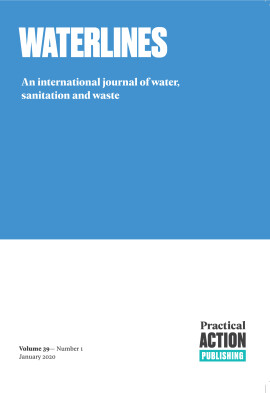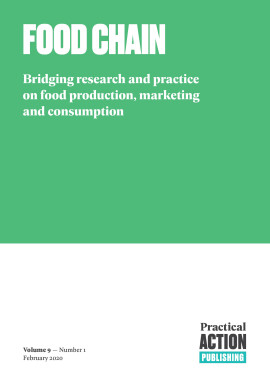Conflicting goals in the management of microfinance institutions: an agency theory approach
Agency theory plays an important role in explaining the behaviour of managers of microfinance institutions (MFIs). These managers face the same problem of simultaneously satisfying conflicting goals as the managers of for-profit companies. In the case of MFIs, a fundamental conflict occurs as management attempts to balance the organization’s social mission against the organization’s need for financial viability. Our paper investigates this issue. We first develop the goal conflict issue as an agency issue. We then develop quantitative measures of financial stress, wealth of borrowers, and the number of loans in the MFI’s loan portfolio. We use OLS regression to measure the relationship between these variables. The resulting regression equation is highly significant, and the variables in the equation all possess the sign predicted by agency theory.Adjei, J., Arun, T. and Hossain, F. (2009) ‘Asset building and poverty reduction in Ghana: the case of microfinance’, Savings and Development 33(3): 265–91.
Bussau, D. (2005) Survival Strategies in the TMED Jungle, Manila, Philippines: Transformational Microenterprise Development Training.
Consultative Group to Assist the Poor (CGAP) (2004) CGAP Annual Report 2004 [online] <https://www.cgap.org/about/key-documents/cgap-annual-report-2004> [accessed 7 February 2020].
Counts, A. (2008) ‘Reimagining microfinance’, Stanford Social Innovation Review 6(3): 45–53.
Cull, R., Demirguc-Kunt, A. and Morduch, J. (2009) ‘Microfinance meets the market’, Journal of Economic Perspectives 23(1): 167–92 <https://doi.org/10.1257/jep.23.1.167>.
Hermes, N. and Lensink, R. (2011) ‘Microfinance: its impact, outreach, and sustainability’, World Development 39(6): 875–81 <https://doi.org/10.1016/j.worlddev.2009.10.021>.
Jensen, M. and Meckling, W. (1976) ‘Theory of the firm: managerial behavior, agency costs and ownership structure’, Journal of Financial Economics 3(4): 305–60.
Kar, A. (2013) ‘Mission drift in microfinance: are the concerns really worrying? Recent cross-country results’, International Review of Applied Economics 27(1): 44–60.
Lebovics, M., Hermes, N. and Hudon, M. (2016) ‘Are financial and social efficiency mutually exclusive? A case study of Vietnamese microfinance institutions’, Annals of Public and Cooperative Economics 87(1): 55–77 <https://doi.org/10.1111/apce.12085>.
Morduch, J. (1999) ‘The microfinance promise’, The Journal of Economic Literature 37(4): 1569–614 <https:/doi.org/10.1257/jel.37.4.1569>.
Navajas, S., Schreiner, M., Meyer, R.L., Gonzalez-Vega, C. and Rodriguez-Meza, J. (2000) ‘Microcredit and the poorest of the poor: theory and evidence from Bolivia’, World Development 28(2): 333–46 <https://doi.org/10.1016/S0305-750X(99)00121-7>.
Nyamsogoro, G.D. (2010) Financial Sustainability of Rural Microfinance Institutions (MFIs) in Tanzania, PhD thesis, University of Greenwich.
Rhyne, E. and Otero, M. (2006) Microfinance through the Next Decade: Visioning the Who, What, Where, When and How, Boston, MA: ACCION International.
Rosenberg, R. (2009) Measuring Results of Microfinance Institutions Minimum Indicators that Donors and Investors Should Track, Washington, DC: World Bank.
Schreiner, M. (2001) ‘Seven aspects of loan size’, Journal of Microfinance/ESR Review 3(2): 27–47.
Spencer, A.M. (2009) ‘Mission drift: what is it, potential impacts, and recovery methods’, Seeking Grant Money Today, 6 September.
Tehulu, T.A. (2013) ‘Determinants of financial sustainability of microfinance institutions in East Africa’, European Journal of Business and Management 5(17): 152–8.
Tucker, M. and Miles, G. (2004) ‘Financial performance of microfinance institutions: comparison to performance of regional commercial banks by geographic regions’, Journal of Microfinance/ESR Review 6(1): 41–54.
World Bank (2019) Data Catalog: MIX market [online] <https://datacatalog.worldbank.org/dataset/mix-market> [accessed 7 February 2020].
World Bank Group (2015) Global Monitoring Report 2014/2015: Ending Poverty and Sharing Prosperity – Overview [online], Washington, DC: World Bank <http://documents.worldbank.org/curated/en/447251468336852219/Global-monitoring-report-2014-2015-ending-poverty-and-sharing-prosperity-overview> [accessed 7 February 2020].
World Bank Group (2016) ‘While poverty in Africa has declined, number of poor has increased’ [online], Washington, DC: World Bank <https://www.worldbank.org/en/region/afr/publication/poverty-rising-africa-poverty-report> [accessed 7 February 2020].
Adjei, J., Arun, T. and Hossain, F. (2009) ‘Asset building and poverty reduction in Ghana: the case of microfinance’, Savings and Development 33(3): 265–91.
Bussau, D. (2005) Survival Strategies in the TMED Jungle, Manila, Philippines: Transformational Microenterprise Development Training.
Consultative Group to Assist the Poor (CGAP) (2004) CGAP Annual Report 2004 [online] <https://www.cgap.org/about/key-documents/cgap-annual-report-2004> [accessed 7 February 2020].
Counts, A. (2008) ‘Reimagining microfinance’, Stanford Social Innovation Review 6(3): 45–53.
Cull, R., Demirguc-Kunt, A. and Morduch, J. (2009) ‘Microfinance meets the market’, Journal of Economic Perspectives 23(1): 167–92 <https://doi.org/10.1257/jep.23.1.167>.
Hermes, N. and Lensink, R. (2011) ‘Microfinance: its impact, outreach, and sustainability’, World Development 39(6): 875–81 <https://doi.org/10.1016/j.worlddev.2009.10.021>.
Jensen, M. and Meckling, W. (1976) ‘Theory of the firm: managerial behavior, agency costs and ownership structure’, Journal of Financial Economics 3(4): 305–60.
Kar, A. (2013) ‘Mission drift in microfinance: are the concerns really worrying? Recent cross-country results’, International Review of Applied Economics 27(1): 44–60.
Lebovics, M., Hermes, N. and Hudon, M. (2016) ‘Are financial and social efficiency mutually exclusive? A case study of Vietnamese microfinance institutions’, Annals of Public and Cooperative Economics 87(1): 55–77 <https://doi.org/10.1111/apce.12085>.
Morduch, J. (1999) ‘The microfinance promise’, The Journal of Economic Literature 37(4): 1569–614 <https:/doi.org/10.1257/jel.37.4.1569>.
Navajas, S., Schreiner, M., Meyer, R.L., Gonzalez-Vega, C. and Rodriguez-Meza, J. (2000) ‘Microcredit and the poorest of the poor: theory and evidence from Bolivia’, World Development 28(2): 333–46 <https://doi.org/10.1016/S0305-750X(99)00121-7>.
Nyamsogoro, G.D. (2010) Financial Sustainability of Rural Microfinance Institutions (MFIs) in Tanzania, PhD thesis, University of Greenwich.
Rhyne, E. and Otero, M. (2006) Microfinance through the Next Decade: Visioning the Who, What, Where, When and How, Boston, MA: ACCION International.
Rosenberg, R. (2009) Measuring Results of Microfinance Institutions Minimum Indicators that Donors and Investors Should Track, Washington, DC: World Bank.
Schreiner, M. (2001) ‘Seven aspects of loan size’, Journal of Microfinance/ESR Review 3(2): 27–47.
Spencer, A.M. (2009) ‘Mission drift: what is it, potential impacts, and recovery methods’, Seeking Grant Money Today, 6 September.
Tehulu, T.A. (2013) ‘Determinants of financial sustainability of microfinance institutions in East Africa’, European Journal of Business and Management 5(17): 152–8.
Tucker, M. and Miles, G. (2004) ‘Financial performance of microfinance institutions: comparison to performance of regional commercial banks by geographic regions’, Journal of Microfinance/ESR Review 6(1): 41–54.
World Bank (2019) Data Catalog: MIX market [online] <https://datacatalog.worldbank.org/dataset/mix-market> [accessed 7 February 2020].
World Bank Group (2015) Global Monitoring Report 2014/2015: Ending Poverty and Sharing Prosperity – Overview [online], Washington, DC: World Bank <http://documents.worldbank.org/curated/en/447251468336852219/Global-monitoring-report-2014-2015-ending-poverty-and-sharing-prosperity-overview> [accessed 7 February 2020].
World Bank Group (2016) ‘While poverty in Africa has declined, number of poor has increased’ [online], Washington, DC: World Bank <https://www.worldbank.org/en/region/afr/publication/poverty-rising-africa-poverty-report> [accessed 7 February 2020].
The Impact of the Federal Government–Amhara Fano Conflict on Microfinance and Economic Outcomes in the Amhara Region, Ethiopia
Ayal, Betselot Adisu
Tassew, Derb Tefera
Alem, Yeshambel Tadele
Kebede, Aschale Tesfahun
Public Organization Review, Vol. 25 (2025), Iss. 3 P.1367
https://doi.org/10.1007/s11115-025-00863-8 [Citations: 0]Role of Governance in Microfinance Sustainability
Microfinance Institutions: Governance Structure, Outreach, and Sustainability
Uddin, Md Nazim
2024
https://doi.org/10.1007/978-981-97-0534-4_2 [Citations: 0]ACHIEVING COMPETITIVE POSITIONING: THE ROLE OF KNOWLEDGE CREATION AND QUALITY IN MANAGEMENT CONSULTANT-CLIENT COLLABORATION
Khanna, Rohan
ShodhKosh: Journal of Visual and Performing Arts, Vol. 4 (2023), Iss. 1
https://doi.org/10.29121/shodhkosh.v4.i1.2023.3961 [Citations: 0]Impact of Internal Corporate Governance Mechanism on Social Performance of Microfinance Institutions in Pakistan
Imran, Zahid
Shafique, Owais
Journal of Accounting and Finance in Emerging Economies, Vol. 8 (2022), Iss. 1 P.59
https://doi.org/10.26710/jafee.v8i1.2186 [Citations: 2]Consequence Management for Irregular Expenditure and Procurement Irregularities: A Qualitative Study of Councillors' Insights and Perspectives in KwaZulu-Natal.
Zungu, Amos
Sibanda, Mabutho
Nomlala, Bomi
International Journal of Applied Research in Business and Management, Vol. 6 (2025), Iss. 1
https://doi.org/10.51137/wrp.ijarbm.2025.azcb.45698 [Citations: 0]Influence of Demographic Factors on Loan Portfolio Quality in the Savings and Credit Cooperatives Societies in Tanzania
Mwaipaja, Festo
Magali, Joseph
EAST AFRICAN JOURNAL OF EDUCATION AND SOCIAL SCIENCES, Vol. 5 (2024), Iss. 3 P.33
https://doi.org/10.46606/eajess2024v05i03.0380 [Citations: 0]- Value chain financing: evidence from Zambia on smallholder access to finance for mechanization
- Boosting financial inclusion through social assistance reform: evidence-based approach in selecting a payment system
- Developing agro-pastoral entrepreneurship: bundling blended finance and technology
- Building frontline market facilitators' capacity: the case of the ‘Integrating Very Poor Producers into Value Chains Field Guide’
- Impact of COVID-19 on livestock exports from Somalia and the Horn of Africa


